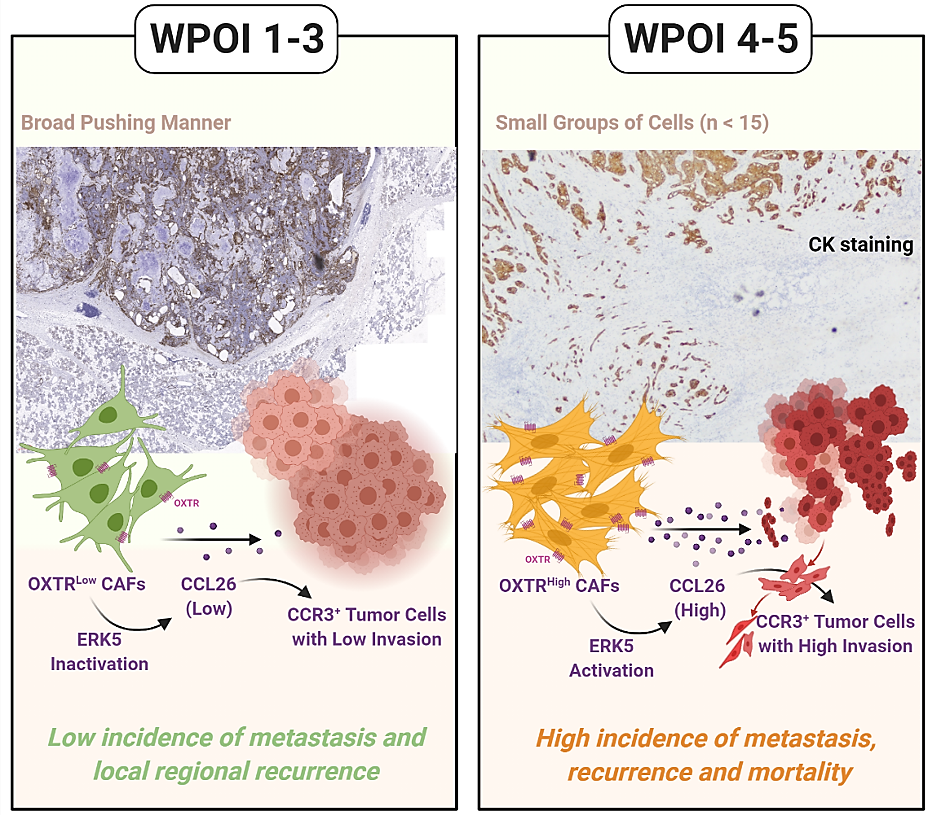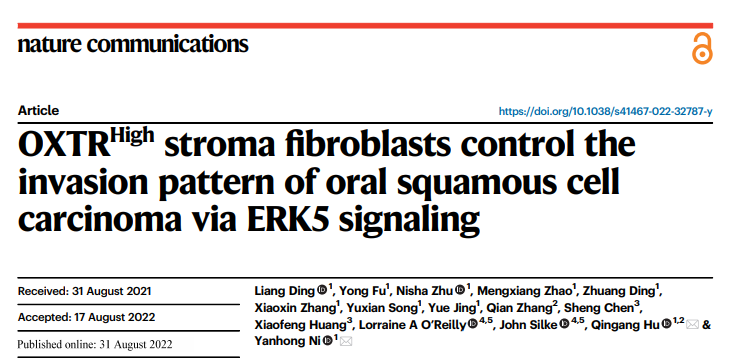Recently, the team of Qingang Hu, Yanhong Ni and Liang Ding from the Central Laboratory of Nanjing Stomatological Hospital, the Affiliated Hospital of Nanjing University Medical School has made important progress in the mechanism of recurrence of oral squamous carcinoma (OSCC). They have identified a new subpopulation of fibroblasts that regulates tumor infiltration and proposed a strategy to alter tumor infiltration by targeting this subpopulation, providing a new therapeutic idea to reduce metastasis and recurrence of tumor in patients with OSCC.
On August 31, 2022, the team published their research results, titled “OXTRHigh stroma fibroblasts control the Invasion Pattern of Oral Squamous Cell Carcinoma via ERK5 Signaling” online in Nature Communications. Ding Liang, Associate Researcher of the Stomatological Hospital was the first author of the article, while Yanhong Ni, Director of the Hospital’s Central Laboratory, and Professor Qingang Hu, Honorary Dean, were the corresponding authors.
Oral squamous carcinoma is a common malignant tumor of the oral and maxillofacial region. Early stage OSCC patients (T1-2N0M0) are treated mainly by surgical resection, but 20-40% of early stage patients still develop local recurrence and occult lymph node metastasis after surgery.
There are multiple modes of tumor infiltration at the point of contact between tumor cells and normal tissue in oral squamous carcinoma, manifested as: low-infiltrating type (Type I. Advancing; Type II. Finger-like infiltration; Type III. mass-like) and highly infiltrative (type IV. Striated or single cell; type V. The presence of tumor satellites 1 mm away from the main cancer nest). Worst pattern of invasion (WPOI) refers to the highest level of infiltration a tumor has. The team previously found that WPOI was an important factor in the recurrence of OSCC in early stage patients; patients with WPOI 4-5 had a significantly shorter survival time and were more likely to develop lymph node metastases after surgery. The team further analyzed the components of the tumor microenvironment in different WPOI types and found that tumor-associated fibroblasts (CAFs) in the interstitium may be an important factor in promoting different WPOI typing; while high-throughput analysis of CAFs in tumor tissues of different WPOI types clarified that oxytocin receptor (OXTR)-positive CAFs in Oxytocin receptor (OXTR) positive CAFs were significantly enriched in the WPOI 4-5 tumor microenvironment. Oxytocin (OXT)-OXTR signaling acts as an important psychological and physiological influence for mood and stress management, modulation of inflammation and antioxidants, but the role in different cancer types is inconclusive. Further in vivo and ex vivo experiments revealed that OXTR can induce tissue infiltration and lymph node metastasis of tumor cells by remodeling tumor mesenchymal composition and promoting CCL26 secretion via ERK5 kinase, providing new ideas for the study of recurrence and metastasis in oral cancer.

Figure 1. Schematic diagram of fibroblast-tumor cell interactions in different WPOI tumor microenvironments.
The research was supported by the Stomatological Hospital, the Department of Oral and Maxillofacial Surgery, the Department of Pathology, the Department of Laboratory Science and the Oral Disease Biosample Bank of the Hospital, as well as by the China Postdoctoral Fund, the National Natural Science Youth Fund, the Natural Science Fund of Jiangsu Province and the Provincial Ministry of Clinical Medicine Centre.

Link to the paper: https://www.nature.com/articles/s41467-022-32787-y



